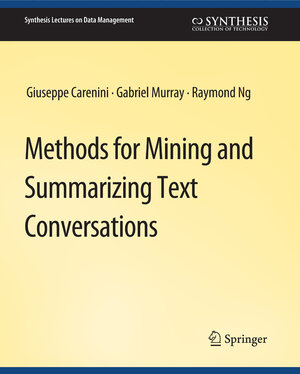
×
![Buchcover ISBN 9783031007521]()
Methods for Mining and Summarizing Text Conversations
von Giuseppe Carenini, Raymond Ng und Gabriel MurrayDue to the Internet Revolution, human conversational data -- in written forms -- are accumulating at a phenomenal rate. At the same time, improvements in speech technology enable many spoken conversations to be transcribed. Individuals and organizations engage in email exchanges, face-to-face meetings, blogging, texting and other social media activities. The advances in natural language processing provide ample opportunities for these „informal documents“ to be analyzed and mined, thus creating numerous new and valuable applications. This book presents a set of computational methods to extract information from conversational data, and to provide natural language summaries of the data. The book begins with an overview of basic concepts, such as the differences between extractive and abstractive summaries, and metrics for evaluating the effectiveness of summarization and various extraction tasks. It also describes some of the benchmark corpora used in the literature. The book introducesextraction and mining methods for performing subjectivity and sentiment detection, topic segmentation and modeling, and the extraction of conversational structure. It also describes frameworks for conducting dialogue act recognition, decision and action item detection, and extraction of thread structure. There is a specific focus on performing all these tasks on conversational data, such as meeting transcripts (which exemplify synchronous conversations) and emails (which exemplify asynchronous conversations). Very recent approaches to deal with blogs, discussion forums and microblogs (e. g., Twitter) are also discussed. The second half of this book focuses on natural language summarization of conversational data. It gives an overview of several extractive and abstractive summarizers developed for emails, meetings, blogs and forums. It also describes attempts for building multi-modal summarizers. Last but not least, the book concludes with thoughts on topics for further development. Table of Contents: Introduction / Background: Corpora and Evaluation Methods / Mining Text Conversations / Summarizing Text Conversations / Conclusions / Final Thoughts



